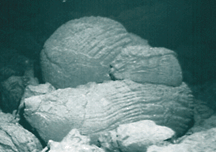

An Island Grows in Hawaii

An Island Grows in Hawaii
|
Hawaii is gaining real estate. An underwater volcano, named Loihi, is being pushed up, and now,
about 100,000 years after it began rising, its crest is within half a mile of the surface.
This is the birth of an island. Robert Bodnar, a volcano expert at Virginia Tech, jokingly suggests that his students should buy the watery property. "Then wait," Bodnar told the Richmond Times-Dispatch. "Sometime within the next 100,000 years, you may own a tropical resort island." Geologists have come to understand the underwater birth of Hawaiian islands only in the last 10 years. The islands are formed as the Pacific Plate moves over a hot spot in Earth's mantle. As the plate glides across, the hot spot melts rocks, causes earthquakes, and pushes up volcanos, some of which become islands.
|
Molten lava piles up in the ocean where it may eventually be part of a new island. Photo courtesy of Hawaii Center of Volcanology |
